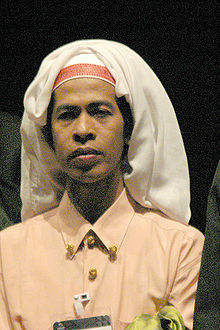La Galigo

La Galigo , also Sureq Galigo , is an epic in the ancient language of the Bugis of Sulawesi ( Indonesia ), which has been handed down in many manuscripts. The text is about 300,000 verses, about 6,000 pages, and is one of the longest literary works ever written (about 20 times the length of the Odyssey ). The epic was written between the 13th and 15th centuries. Although La Galigo is not considered a historical work, it does give historians an idea of the Bugis society of South Sulawesi in the 14th century. The manuscript, kept in the University Library in Leiden , was entered in the UNESCO Memory of the World Register on May 25, 2011 because of its worldwide importance and exceptional universal value .
La Galigo is the name of a character in this story, the epic tells the myth of creation, included in the adventures of the great warrior Sawerigading and his incestuous love for his twin sister We Tenriabeng .
content
Sawèri-gàding La-Tanritâppu Pamàdalâtte Lâwe Towanjompa La-Madukallang Lângi-puwang Prince of Wâra (in Luwu ), called Sawerigading for short , is the son of the king of Luwu, Batara Lattu , and the grandson of Batara Guru , who was the first god of the Heaven descended on earth. In his youth Sawerigading made a number of trips that took him to Celebes , the Moluccas and Sumbawa , as well as some unidentifiable countries. One of these trips took him to the island of the cosmic tree Pao Jengki , whose branches reach into the sky and whose roots reach to the center of the earth. He sees the great ocean vortex that moves all the waters in the world and even penetrates twice into the land of death. During the first stay there, he has to refrain from taking the recently deceased Princess We Pinrakati with him to the upper world; on the second attempt he succeeds in bringing Welle ri Lino back to the living.
When he returned to Luwu, Sawerigading saw his twin sister We Tenriabeng , who was separated from him at birth , for the first time and with whom he fell in love immediately. He does not want to accept all the reproaches of his followers and also the contradiction of We Tenriabeng , but decides to marry her. As a last resort, his sister reports of a cousin, We Cudai , who lives in the land of Cina and is exactly like her. She gives her brother a strand of hair, one of her bracelets and a ring to take with her on the trip. Sawerigading carves a ship out of the trunk of the gigantic Welenreng tree , which he has to cut down. All the nests of the birds nesting in the crown fall down, the eggs break and cause a huge flood. Therefore, Sawerigading makes the atonement vow never to step on the ground of Luwu again.
After many adventures and battles, he finally finds We Cudai and marries her. They have a son La Galigo , who gives the epic its name, and a daughter We Tenrido , who is being trained as a bissu ( shaman , medium ). When his grandson La Tenritatta marries and Sawerigading breaks his vow never to enter Luwu again, he and We Cudai are swallowed up in a wave. In the lower world he takes over from Guri ri Selling , his sister We Tenriabeng and her husband Remmang ri Langi become rulers of the upper world. When one of Sawerigading's daughters and one of We Tenriabeng's sons get married and have children, the connection between the world and heaven is finally extinguished and humanity is left to fend for itself.

reception
Director Robert Wilson created I La Galigo , a stage adaptation of La Galigo , in 2004 . The performances took place in 2004 and 2005 in Singapore , Amsterdam , Barcelona , Madrid , Lyon , Ravenna , New York City , Jakarta and Melbourne .
The well-known ethnic dancer Coppong Daeng Rannu (* 1920 in Gowa , South Sulawesi) from Makassar danced the figure of the rice goddess.
Web links
Individual evidence
- ↑ La Galigo | United Nations Educational, Scientific and Cultural Organization. Retrieved August 28, 2017 .
- ↑ Alexander Baumgartner: History of world literature: The literatures of India and East Asia . 1st and 2nd edition. Herder, 1902, p. 618 ff . ( limited preview in Google Book search).
- ^ Yves Bonnefoy: Asian mythologies , p. 170.
- ^ Maria Shevtsova: Robert Wilson . In: Routledge Performance Practitioners . Taylor & Francis, 2007, ISBN 978-0-203-44845-8 , pp. 39 ff . ( limited preview in Google Book search).


